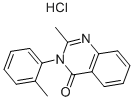METHAQUALONE HYDROCHLORIDE
- CAS NO.:340-56-7
- Empirical Formula: C16H15ClN2O
- Molecular Weight: 286.76
- MDL number: MFCD00058185
- EINECS: 206-431-2
- SAFETY DATA SHEET (SDS)
- Update Date: 2023-05-04 15:14:09

What is METHAQUALONE HYDROCHLORIDE?
Originator
Quaalude ,Lemmon,US,1965
Manufacturing Process
Anthranilic acid (1 part) is dissolved in acetic anhydride (2 parts) and the temperature raised progressively to 190° to 200°C while distillation takes place. The last traces of acetic acid are removed under vacuum and, after cooling to about 50° to 60°C, o-toluidine (1 part) is added in portions.
The temperature is then raised to 170° to 200°C when the excess water and o-toluidine is gradually distilled off, finally maintaining the temperature at 180° to 200°C for 2 hours. After cooling to about 100°C dilute hydrochloric acid (3 parts) is added and the mixture boiled and stirred. The solution is then neutralized with NaOH with stirring and the product which separates is recrystallized twice from alcohol after decolorizing with carbon. Yield: 70% of theoretical, LIP 114° to 115°C.
Therapeutic Function
Hypnotic
Safety Profile
Poison by ingestion, intraperitoneal, and intravenous routes. An experimental teratogen. Experimental reproductive effects. Human systemic effects. convulsions, dyspnea, pulse rate increase. When heated to decomposition it emits very toxic fumes of NOx and HCl.
Properties of METHAQUALONE HYDROCHLORIDE
| Melting point: | 255-265° |
| Flash point: | 11 °C |
| storage temp. | 2-8°C |
Safety information for METHAQUALONE HYDROCHLORIDE
Computed Descriptors for METHAQUALONE HYDROCHLORIDE
New Products
4-AMINO-TETRAHYDRO-PYRAN-4-CARBOXYLIC ACID HCL 4-(Dimethylamino)tetrahydro-2H-pyran-4-carbonitrile 4-Aminotetrahydropyran-4-carbonitrile Hydrochloride (R)-3-Aminobutanenitrile Hydrochloride 3-((Dimethylamino)methyl)-5-methylhexan-2-one oxalate 1,4-Dioxa-8-azaspiro[4.5]decane 5-Bromo-2-nitropyridine Nimesulide BP Aceclofenac IP/BP/EP Diclofenac Sodium IP/BP/EP/USP Mefenamic Acid IP/BP/EP/USP Ornidazole IP Diclofenac Potassium THOMAIND PAPER PH 2.0 TO 4.5 1 BOX BUFFER CAPSULE PH 9.2 - 10 CAP SODIUM CHLORIDE 0.1N CVS ALLOXAN MONOHYDRATE 98% PLATINUM 0.5% ON 3 MM ALUMINA PELLETS (TYPE 73) LITHIUM AAS SOLUTION 2-Bromo-1-(bromomethyl)-3-chloro-5-nitrobenzene 2-Bromo-3-nitroaniline N-(3-Hydroxypropyl)-N-methylacetamide 3-Bromo-6-chloropyridazine 4-ethyl-3-nitrobenzoic acidRelated products of tetrahydrofuran
![6,8-DICHLORO-3-(2,6-DIMETHYLPHENYL)-2-(([3-(TRIFLUOROMETHYL)PHENYL]SULFANYL)METHYL)-4(3H)-QUINAZOLINONE](https://img.chemicalbook.in/StructureFile/ChemBookStructure3/GIF/CB4269582.gif)
![2-([(2-CHLOROBENZYL)SULFANYL]METHYL)-3-(4-CHLORO-2-METHYLPHENYL)-4(3H)-QUINAZOLINONE](https://img.chemicalbook.in/StructureFile/ChemBookStructure3/GIF/CB6156255.gif)
![2-Metil-3-(2-carbossietildietilammino-6-metil-fenil)-4-chinazolone clo ridrate [Italian]](https://img.chemicalbook.in/CAS/GIF/2619-07-0.gif)
![2-([(4-BROMOPHENYL)SULFANYL]METHYL)-6,8-DICHLORO-3-(2,6-DIMETHYLPHENYL)-4(3H)-QUINAZOLINONE](https://img.chemicalbook.in/StructureFile/ChemBookStructure3/GIF/CB6757519.gif)
![2-([(4-BROMOPHENYL)SULFANYL]METHYL)-6-CHLORO-3-(2-METHYLPHENYL)-4(3H)-QUINAZOLINONE](https://img.chemicalbook.in/StructureFile/ChemBookStructure3/GIF/CB8158743.gif)
![6-CHLORO-3-(2-METHYLPHENYL)-2-(([3-(TRIFLUOROMETHYL)PHENYL]SULFANYL)METHYL)-4(3H)-QUINAZOLINONE](https://img.chemicalbook.in/StructureFile/ChemBookStructure3/GIF/CB7257854.gif)
![6-CHLORO-2-([(2,6-DICHLOROPHENYL)SULFANYL]METHYL)-3-(2-METHYLPHENYL)-4(3H)-QUINAZOLINONE](https://img.chemicalbook.in/StructureFile/ChemBookStructure3/GIF/CB6473752.gif)
![3-(4-CHLORO-2-METHYLPHENYL)-2-([(2,6-DICHLOROPHENYL)SULFANYL]METHYL)-4(3H)-QUINAZOLINONE](https://img.chemicalbook.in/StructureFile/ChemBookStructure3/GIF/CB6750121.gif)
You may like
-
 1-Methyl-6-oxo-1,6-dihydropyridazine-3-carbonitrile 98%View Details
1-Methyl-6-oxo-1,6-dihydropyridazine-3-carbonitrile 98%View Details
99903-60-3 -
 88491-46-7 98%View Details
88491-46-7 98%View Details
88491-46-7 -
 1823368-42-8 98%View Details
1823368-42-8 98%View Details
1823368-42-8 -
 2-(3-(tert-butyl)phenoxy)-2-methylpropanoic acid 1307449-08-6 98%View Details
2-(3-(tert-butyl)phenoxy)-2-methylpropanoic acid 1307449-08-6 98%View Details
1307449-08-6 -
 Ethyl 3-(furan-2-yl)-3-hydroxypropanoate 25408-95-1 98%View Details
Ethyl 3-(furan-2-yl)-3-hydroxypropanoate 25408-95-1 98%View Details
25408-95-1 -
 2-Chloro-5-fluoro-1-methoxy-3-methylbenzene 98%View Details
2-Chloro-5-fluoro-1-methoxy-3-methylbenzene 98%View Details
1805639-70-6 -
 1784294-80-9 98%View Details
1784294-80-9 98%View Details
1784294-80-9 -
 Lithium ClavulanateView Details
Lithium ClavulanateView Details
61177-44-4